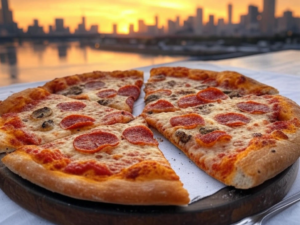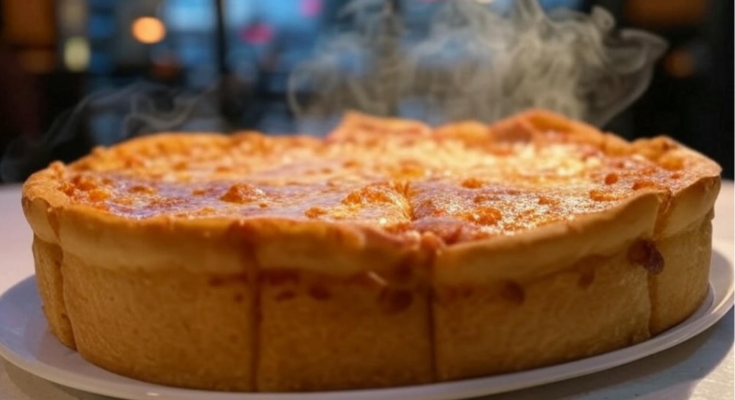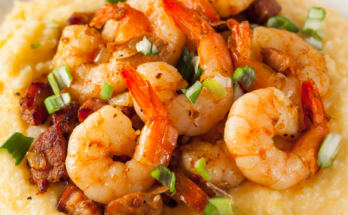When you think of pizza, your mind might drift to the thin, crispy crusts of New York or the classic Neapolitan pies straight from Italy. But if you’re a fan of bold flavors, towering layers, and a meal that’s as hearty as it is delicious, then Chicago-style pizza deserves a spot on your radar. This isn’t just pizza—it’s an experience, a culinary masterpiece born in the heart of the Windy City. In this post, we’ll explore what makes Chicago-style pizza so unique, its history, how it’s made, and where you can find the best slices (or rather, slabs) in Chicago and beyond.
What Is Chicago-Style Pizza?
Chicago-style pizza isn’t your average pie. It’s most famously known as “deep-dish,” a term that only scratches the surface of its identity. Picture this: a thick, buttery crust rising high along the edges of a deep pan, cradling layers of cheese, toppings, and a generous blanket of chunky tomato sauce. Unlike traditional pizza where the sauce sits beneath the toppings, Chicago-style flips the script—sauce goes on top, locking in the flavors as it bakes into a gooey, satisfying creation.
There’s also a lesser-known cousin called “stuffed pizza,” which takes deep-dish to another level by adding an extra layer of dough over the toppings before the sauce is applied. Both styles are indulgent, filling, and unmistakably Chicagoan. A single slice is often a meal in itself, making it perfect for sharing—or for those with a serious pizza obsession.
A Brief History of Chicago-Style Pizza
The story of Chicago-style pizza begins in 1943, when Ike Sewell, a Texas-born entrepreneur, and his business partner Ric Riccardo opened Pizzeria Uno in Chicago’s Near North Side. Sewell had a vision: he wanted to create a pizza that was more substantial than the flat, simple pies of the time. Inspired by Italian-American cooking and his own bold ideas, he developed a recipe for a deep-dish pizza baked in a cake-like pan. The result was a hit—rich, flavorful, and unlike anything Chicagoans had tasted before.
Pizzeria Uno became the birthplace of deep-dish pizza, and its success sparked a legacy. Soon, other spots like Lou Malnati’s, Gino’s East, and Pequod’s emerged, each putting their own spin on the style while staying true to its core: a thick crust, heaps of cheese, and that signature sauce-on-top approach. Over the decades, Chicago-style pizza became a point of pride for the city, a symbol of its blue-collar roots and love for hearty, no-nonsense food.
How Chicago-Style Pizza Is Made

Making Chicago-style pizza is an art form that requires patience and precision. Here’s a breakdown of the process:
-
- The Crust: It all starts with the dough. Unlike thin-crust pizza, Chicago-style dough is richer, often enriched with butter or oil to create a flaky, biscuit-like texture. It’s pressed into a deep, round pan—sometimes 2 to 3 inches high—and pulled up the sides to form a sturdy wall that holds everything together.
-
- The Cheese: Next comes a generous layer of mozzarella, laid directly on the dough. This acts as a barrier between the crust and the toppings, ensuring the base stays crisp while the cheese melts into a stretchy, golden blanket.
-
- The Toppings: From Italian sausage (a Chicago favorite) to pepperoni, onions, peppers, or mushrooms, the toppings are piled in next. Because of the depth, you can load up more than you would on a typical pizza—there’s room to get creative.
-
- The Sauce: The pièce de résistance is the sauce. Made from crushed or chunky tomatoes, it’s seasoned with oregano, basil, and garlic, then ladled over the top. This reverse layering protects the cheese and toppings from burning during the long bake time and gives the pizza its distinctive look.
-
- The Bake: Chicago-style pizza isn’t a quick affair. It bakes at a moderate temperature (around 425°F) for 30-45 minutes, allowing the flavors to meld and the crust to turn golden brown. The result? A pizza that’s crispy on the outside, soft inside, and packed with flavor in every bite.
Why Chicago-Style Pizza Stands Out
So, what sets Chicago-style apart from other pizzas? It’s more than just the depth—it’s the philosophy behind it. This is a pizza built for satisfaction, designed to feed a crowd or fuel a hardworking city. The thick crust and abundant toppings reflect Chicago’s reputation for excess in the best way possible. It’s not delicate or subtle; it’s unapologetically bold.
Then there’s the sauce-on-top factor. While it might confuse purists at first, it’s a game-changer. The sauce caramelizes slightly as it bakes, adding a sweet-savory depth that ties the whole dish together. Plus, the sheer volume of cheese—often more than a pound per pie—makes every bite an indulgent escape.
Where to Try Chicago-Style Pizza
If you’re in Chicago, you’re in luck—the city is brimming with legendary spots to sample this iconic dish. Here are a few must-visit places:
-
- Pizzeria Uno: The original deep-dish pioneer still serves up pies with that classic buttery crust and chunky sauce. Its sister location, Pizzeria Due, just a block away, is another great option.
-
- Lou Malnati’s: A local favorite since 1971, Lou’s is famous for its “Buttercrust” and perfectly spiced sausage. With dozens of locations across the city, it’s a go-to for deep-dish lovers.
-
- Gino’s East: Known for its graffiti-covered walls and cornmeal-dusted crust, Gino’s offers a slightly crunchier take on the style.
-
- Pequod’s Pizza: A cult classic, Pequod’s is revered for its caramelized cheese edges—called “the crown”—that form a crispy, golden ring around the pie.
Not in Chicago? Many of these spots ship frozen pizzas nationwide, so you can enjoy an authentic slice from your own oven. Alternatively, try your hand at making it at home—the process is rewarding, even if it takes a little practice to nail the crust.
Chicago-Style Pizza vs. the World
It’s impossible to talk about Chicago-style pizza without mentioning its rivalry with New York-style. The debate between the two is as old as time (or at least as old as the pizzas themselves). New Yorkers tout their thin, foldable slices as the ultimate pizza experience, while Chicagoans argue that deep-dish is the true king of flavor and substance. Truth is, they’re different beasts—New York is quick and street-friendly, while Chicago is a sit-down, fork-and-knife affair. Why choose when you can love both?
Then there’s the stuffed pizza debate within Chicago itself. Places like Giordano’s swear by their double-crusted version, claiming it’s the pinnacle of indulgence. Deep-dish purists might disagree, but one thing’s for sure: Chicago-style pizza, in all its forms, is a force to be reckoned with.
Tips for Enjoying Chicago-Style Pizza
Ready to dig in? Here are a few pointers to enhance your experience:
-
- Bring Friends: One pie can easily feed 3-4 people, so it’s perfect for a group outing.
-
- Use a Fork: While you can pick up a slice, the weight and messiness often call for utensils—at least for the first few bites.
-
- Pair It Right: A cold beer or a bold red wine complements the richness beautifully.
-
- Save Room: It’s filling, so pace yourself. A side salad can balance out the meal if you’re feeling ambitious.
Making Chicago-Style Pizza at Home
If you’re inspired to recreate this masterpiece, start with a good deep-dish pan (a cast-iron skillet works in a pinch). Use a high-fat dough recipe, layer generously, and don’t skimp on bake time. There are plenty of recipes online, but the key is patience—rushing it won’t do justice to the Windy City’s finest.
Final Thoughts
Chicago-style pizza is more than food—it’s a celebration of creativity, flavor, and the spirit of a city that doesn’t do anything halfway. Whether you’re a lifelong fan or a curious newbie, there’s something magical about slicing into that towering pie and discovering the layers within. So next time you’re craving pizza, skip the ordinary and go deep. Chicago-style isn’t just a meal; it’s a delicious adventure.
Have you tried Chicago-style pizza? What’s your favorite topping combo? Drop a comment below—I’d love to hear your thoughts!



